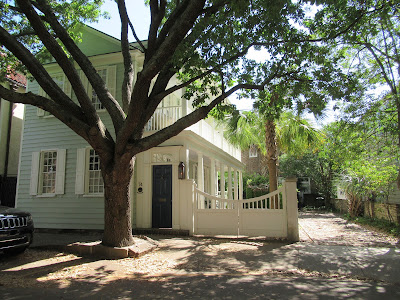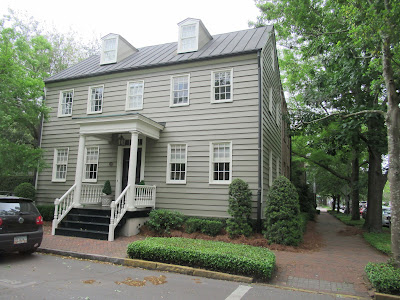Charleston is South Carolina's oldest and largest city. Located on a natural harbor, the city is well known for its rich history and well-preserved architecture making it a popular tourist destination. Through the years it has been nicknamed "The Holy City" because of the many elegant steeples that shape the city's skyline.
During our visit to Charleston, we did a lot of walking as we stepped back in time to learn about Charleston's multifarious past ... a colorful history that included war heroes as well as slave owners. The history nerd like myself could easily spend days wandering through the cobblestone streets and touring old homes and plantations.
But I know that I would need something to entice Doug with. I was happy to see that one recent addition to the Charleston tourist scene ... the expansion of their craft breweries ... would provide the "reward" Doug needed after these many days of stepping through history with me.
Our first day in town, we parked by the Charleston Visitor Center and picked up a city map. Because of the long line of visitors inquiring about tours, we decided to head out on our own. The Visitor Center is on the northern border of the older part of town, so we walked about a half mile to where the historic district begins. We did not have much background information as to what we were seeing, but we were happy to just enjoy the unique Charleston sights.
 |
| The Charleston City Market stretches on for blocks offering food and crafts that reflect the Southern culture. |
 |
| Local artisans could be seen weaving sweetgrass baskets, containers and decorative items. They could all be mine ... if I had room for such intricacies. |
 |
| A statue remembering the Confederate defenders stands at the tip of Charleston's White Point Gardens in a section of town known as "The Battery". |
 |
| Elegant homes that line the harbor's edge ... |
 |
| ... and the neighborhoods piqued my interest in learning more about the history of the people who called these houses "home". |
Walking on our own around Charleston was a good way to get an initial taste for the city, but I wanted to know the significance of what I was seeing. How did these elegant homes rise up? And how is it that 250 years later, they are still shining in their youthful glory? So I googled "walking tours of Charleston" and came across the "Charleston in a Nutshell" tours lead by Charleston native, Jim Zimmerman. For $20, he lead our small group on a two hour hike around the oldest parts of town and filled us in on the significance of the beautiful architecture before us. So "in a nutshell", here is some of what I learned.
 |
| Rainbow Row is a row of classic Charleston style homes painted in various pastel colors. Starting in 1931, Dorothy Porcher Legge purchased and restored a section of these homes. Her efforts are credited beginning the revitalization of historic homes in Charleston. |
 |
| George Washington Slept Here! Charleston homes are famous not only for who owned them, but also for who may have visited them. |
 |
| The "single house" is a classic Charleston style home. With its narrow edge toward the street, it fit well on the long narrow lots found in historic Charleston. |
 |
| Tiffany stained glass adorn the windows of St Michael's Episcopal Church, the oldest surviving religious structure in Charleston. |
 |
| A few blocks down the street near the waterfront is a grim reminder of how much of this wealth came to be. It is estimated that about half of the African slaves that were brought to America before 1808 arrived in Charleston. The Old Slave Mart was used as a slave auction gallery in 1859. |
Slavery, unfortunately, is also a part of Charleston's history, and I hoped to learn more by visiting one of the many plantations in the area. There are plenty to choose from, but I am glad that we visited the McLeod Plantation Historic Site. Located just three miles from our campground, McLeod Plantation reflects on the history from the enslaved peoples' perspective. For $15, we embarked on a 90 minute tour in which our guide, Barbara, showed us the often tumultuous journey the enslaved population faced as they made the transition from slavery to freedom.
 |
| Sea Island cotton, shown here, was the main crop grown on this 1600 acre plantation. It was very labor intensive to grow, but because of its extra long, strong and soft fibers, it was in high demand and thus, brought the McLeods a good deal of money. |
 |
| The McLeods were considered a part of the upper middle class in their comfortable plantation home. |
 |
| The front porch looks out over the fields where the enslaved men and women prepared the fields, planted and processed the cotton and other food used by the family. |
 |
| The outhouse, located in the woods behind the cabins, was expected to be used by all. It is hard to imagine living in such conditions without running water and electricity well into the 20th century. |
 |
| Turmoil for the former enslaved people also continued well into the 20th century. One cabin floor shows the shoe marks left on the wooden floor when a flash fire forced the family out of their "home". |
 |
| If this huge 300 year oak could talk ... it would tell us that freedom begins when we understand the struggles of our fellow brothers and sisters and treat them with kindness. |
Not far from McLeod Plantation is another important site in Charleston's history ... Charles Towne Landing Historic Site.
Charles Towne Landing is the original birthplace of the Carolina colony. In 1670, a group of English settlers established the first permanent settlement in the area. The colony was moved to the present site of Charleston in 1680, but this area has been preserved by the state as a beautiful historic park.
 |
| The visitors center and museum have excellent interactive exhibits showing what life was like in Charles Towne. |
 |
| The one and a half mile walk around the park brings us to the defense wall that was built to protect them from their enemies. |
 |
| A replica of one of the settlement's structures complete with a costumed guide gave us a view of life in 1670s. |
 |
| At the river's edge "The Adventurer", a working replica of the 17th century trading vessels, is anchored. Come aboard and the costumed guide will sign you up for the next voyage to England! |
 |
| All these "steps" back in time has Doug seeking out a resting spot, as he researches his next craft brew reward. |
 |
| Which he easily does! Frothy Beard Brewery has a wall covered with stickers from other local breweries and much to our surprise, two of our favorite Rochester, MN breweries are there. Can you spot them?? |
During our visit, we stayed at the James Island County Park Campground. The Charleston County Park system does a great job of managing this as well as the McLeod Plantation and a few beaches in the area.
Located about seven miles from downtown, it offers convenient access many of Charleston's attractions. The large park setting provided a relaxing retreat as well after a full day of sightseeing.
Hiking, biking, kayaking and wall climbing opportunities were also available just in case I didn't tire Doug out enough ...
... with our many "steps" back in time!
Until next time ... Make your steps historical ... and enjoy the adventures in your life!














































